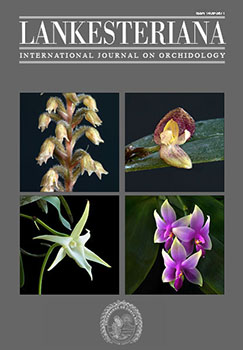<i>Restrepia restrepoi</i>: a new species from the cloud forests of the Colombian Western Andes
DOI:
https://doi.org/10.15517/lank.v25i1.63853Keywords:
Dapa, endemic species, Orchidaceae, Pleurothallidiinae, Restrepia aberrans, Restrepia chrysoglossa, Restrepia flosculata, taxonomyAbstract
A new species of Restrepia from the Department of Valle del Cauca, found exclusively in the montane rainforest of the Western Colombian Andes, is described and illustrated. This new species is morphologically similar to Restrepia chrysoglossa, another species endemic to Valle del Cauca; however, it can be distinguished by its brown-spotted sheaths, cleistogamous non-spreading flowers, oblong, attenuated, non-clavate dorsal sepal, and pyriform, when expanded, ovate lip. We discuss its morphological affinities and provide notes on its conservation status and ecology, highlighting its restricted distribution and potential threats to its habitat, along with a distribution map.
Downloads
References
BGCI. (2023). ThreatSearch online database. Botanic Gardens Conservation International. Richmond, UK. www.bgci.org/threat_search.php.
Calderón-Sáenz, E. (Ed.). (2007). Libro Rojo de Plantas de Colombia. Volumen 6: Orquídeas, Primera Parte. Instituto Alexander von Humboldt – Ministerio de Ambiente, Vivienda y Desarrollo Territorial.
Christmann, T., Palomeque, X., Armenteras, D., Wilson, S. J., Malhi, Y., & Oliveras Menor, I. (2023). Disrupted montane forest recovery hinders biodiversity conservation in the tropical Andes. Global Ecology and Biogeography, 32(5), 793–808. https://doi.org/10.1111/geb.13666
Chumová, Z., Záveská, E., Hloušková, P., Ponert, J., Schmidt, P.-A., Čertner, M., Mandáková, T., & Trávníček, P. (2021), Repeat proliferation and partial endoreplication jointly shape the patterns of genome size evolution in orchids. Plant J, 107, 511–524. https://doi.org/10.1111/tpj.15306
Epidendra. (2025). The Global Orchid Taxonomic Network. Retrieved from http://www.epidendra.com [Accessed 12 January 2025].
Fernández, M., Bogarín, D., Karremans, A. P., & Jiménez, D. (2014). New species and records of Orchidaceae from Costa Rica. III. Lankesteriana, 13(3), 259–282. https://doi.org/10.15517/lank.v13i3.14363
Gutiérrez Morales, N. G., Moreno, J. S., Karremans, A. P., & Gil-Amaya, K. (2023). Restrepia santanderensis (Orchidaceae: Pleurothallidinae), a new species from the western slope of the eastern Andes in Colombia. Phytotaxa, 598(4), 293–300. https://doi.org/10.11646/phytotaxa.598.4.3
Holdridge, L. (1987). Ecología basada en zonas de vida. San José, Costa Rica: IICA.
IPNI. (2025). International Plant Names Index. The Royal Botanic Gardens, Kew, Harvard University Herbaria & Libraries and Australian National Herbarium. Retrieved from http://www.ipni.org (Accessed 12 January 2025).
IUCN. (2020). The IUCN Red List of threatened species v. 2019-3.
Karremans, A. P. (2016). Genera Pleurothallidinarum: an updated phylogenetic overview of Pleurothallidinae. Lankesteriana, 16, 219–241. https://doi.org/10.15517/lank.v16i2.26008
Karremans, A. P., Moreno, J. S., Gil-Amaya, K., Gutiérrez Morales, N., Espinosa, F., Mesa, S., Restrepo, E., Rincón-González, M., Serna, A., Sierra-Ariza, M., & Vieira-Uribe, S. (2023). Colombian Orchidaceae: a catalogue of the Pleurothallidinae. Lankesteriana, 23(2), 181–400. https://doi.org/10.15517/lank.v23i2.56158
Luer, C.A. (1996). Icones Pleurothallidinarum XIII. Systematics of the genus Restrepia (Orchidaceae). Monographs in Systematic Botany from the Missouri Botanical Garden, 59, 1–168.
Luer, C. A., & Thoerle, L. (2012). Icones Pleurothallidinarum XXXII. Lepanthes of Colombia (Orchidaceae). Monographs in Systematic Botany from the Missouri Botanical Garden, 123, 1–300.
Ortiz V., P., Pérez-Escobar, O. A., & Parra-Sánchez, E. (2011). Una nueva y peculiar especie de Lepanthes (Orchidaceae) de Colombia. Orquideología, 28, 22–26.
Ospina-Calderón, N. H., Tremblay, R. L., Torres, A. M., & Flanagan, N. S. (2023). The effect of habitat transformation on a twig epiphytic orchid: Evidence from population dynamics. Frontiers in Ecology and Evolution, 11, 1–12. https://doi.org/10.3389/fevo.2023.1135316
Parra Sánchez, E., Armenteras, D., & Retana, J. (2016). Edge Influence on Diversity of Orchids in Andean Cloud Forests. Forests, 7, 63. https://doi.org/10.3390/f7030063
Parra-Sánchez, E., Pérez-Escobar, O. A., & Edwards, D. P. (2023). Neutral-based processes overrule niche-based processes in shaping tropical montane orchid communities across spatial scales. Journal of Ecology, 111(8), 1614–1628. https://doi.org/10.1111/1365-2745.14140
Pérez‐Escobar, O. A., Chomicki, G., Condamine, F. L., Karremans, A. P., Bogarín, D., Matzke, N. J., ... & Antonelli, A. (2017). Recent origin and rapid speciation of Neotropical orchids in the world's richest plant biodiversity hotspot. New Phytologist, 215(2), 891–905. https://doi.org/10.1111/nph.14629
Pérez-Escobar, O. A., Zizka, A., Bermúdez, M. A., Meseguer, A. S., Condamine, F. L., Hoorn, C., ... & Chomicki, G. (2022). The Andes through time: evolution and distribution of Andean floras. Trends in Plant Science, 27(4), 364–378. https://doi.org/10.1016/j.tplants.2021.09.010
QGIS. (2021). QGIS Geographic Information System. QGIS Association. Retrieved from QGIS.org
Rabinowitz, D. (1981). Seven forms of rarity. In H. Synge (Ed.), The Biological Aspects of Rare Plants Conservation (pp. 205–217). John Wiley & Sons Ltd.
Reina-Rodríguez, G. A., López-Machado, F., & Martel, C. (2019). Telipogon mayoi (Orchidaceae), a new species from the Western Andes of Colombia. Lankesteriana, 19(3), 263–270. https://doi.org/10.15517/lank.v19i3.39969
Reina-Rodríguez, G. A., Ormerod, P., Rubiano-Hurtado, M., & Rubiano-Mejia, J.E. (2022). Two New Species of Crossoglossa (Orchidaceae, Malaxideae) from the Western Andes of Colombia. Harvard Papers in Botany, 27(1), 101–105. https://doi.org/10.3100/hpib.v27iss1.2022.n13
Rodríguez Eraso, N., Armenteras-Pascual, D., & Alumbreros, J. R. (2013). Land use and land cover change in the Colombian Andes: Dynamics and future scenarios. Journal of Land Use Science, 8(2), 154–174. https://doi.org/10.1080/1747423X.2011.650228
Rojas-Alvarado, G., & Karremans, A. (2024). A typological and morphological analysis of the Pleurothallidinae (Orchidaceae) inflorescences. The Botanical Review, 90, 221–250. https://doi.org/10.1007/s12229-024-09303-6
Tadono, T., Ishida, H., Oda, F., Naito, S., Minakawa, K., & Iwamoto, H. (2014). Precise Global DEM Generation by ALOS PRISM. ISPRS Annals of the Photogrammetry, Remote Sensing and Spatial Information Sciences, II-4, 71–76. https://doi.org/10.5194/isprsannals-II-4-71-2014
Thiers, B. (2024). Index Herbariorum: A global directory of public herbaria and associated staff [continuously updated]. New York Botanic Garden’s Virtual Herbarium. Retrieved from http://sweetgum.nybg.org/science/ih [Accessed XX, XX, XXXX]
Tropicos. (2025). Retrieved from http://www.tropicos.org [Accessed 12 January 2025].
Vogel, S. (1990). The role of scent glands in pollination: on the structure and function of osmophores. Washington, D.C.: Smithsonian Institution Libraries and The National Science Foundation.
Zepner, L., Karrasch, P., Wiemann, F., & Bernard, L. (2020). ClimateCharts.net – an interactive climate analysis web platform, International Journal of Digital Earth, 14(3), 338–356. https://doi.org/10.1080/17538947.2020.1829112

Published
How to Cite
Issue
Section
License
Copyright (c) 2025 Lankesteriana: International Journal on Orchidology

This work is licensed under a Creative Commons Attribution-NonCommercial-NoDerivatives 3.0 Unported License.
According to the Open Access policy promoted by the University of Costa Rica, all the papers published by Lankesteriana are licensed under the Creative Commons copyright and can be downloaded free of charge. The journal holds copyright and publishing rights under the CC BY-NC-ND 3.0 CR license.
Before the publication of the materials submitted by the author(s) in LANKESTERIANA, the author(s) hereby assign all rights in the article to the Lankester Botanical Garden.




